Have you ever been in the middle of an important task only to have Windows decide it’s time for an update—and that update requires a lightning-fast, never-ending internet connection? Enter the realm of offline update of Windows 10 and Windows 11, where you can download the update package, transfer it via USB, and install it at your leisure. In this guide, we’ll walk you through using the offline update installer Windows 10 method, provide direct download links, and cover everything you need to know to install Windows update offline. Say goodbye to frustrating update interruptions and hello to a smoother, more controlled process.
What Is an Offline Update?
An offline update allows you to download the necessary update files from a reliable network or another computer, then install them without an active internet connection. This method is ideal when:
– Internet is slow or unreliable: No more waiting for updates to download at a snail’s pace.
– Multiple systems need updating: A single downloaded package can be shared among several devices.
– Controlled update process: You decide when and how updates are applied.
Essential Download Links
Before we dive into the steps, here are some essential links to get you started:
-
Windows Update Catalog:
Visit Windows Update Catalog
Search for the specific KB update number you need, then download the corresponding package. -
Windows 10 Media Creation Tool:
Download Windows 10 Media Creation Tool
This tool can also help you create bootable installation media. -
Windows 11 Installation Assistant & Media Creation Tool:
Download Windows 11 Tool
Use this to download offline update packages or create installation media for Windows 11.
Step-by-Step Guide to Offline Updating Windows 10
1. Download the Offline Update Package
- Identify the Update:
Determine the specific update you need (for example, KB5006670 for Windows 10). - Visit the Windows Update Catalog:
Use the link above, enter the KB number in the search bar, and choose the correct version for your system (32-bit or 64-bit). - Download the .msu File:
Save the file to your computer or directly onto a USB drive if possible.
2. Prepare Your Device
- Backup Your Data:
Although installing an update is generally safe, back up critical files just in case. - Format Your USB Drive (if needed):
Ensure your USB drive is formatted in NTFS to support larger files. - Tip: Right-click the USB drive in File Explorer, select “Format,” choose NTFS, and click “Start.”
3. Transfer and Run the Update
- Transfer the Update File:
Copy the downloaded .msu file from your computer to your USB drive if it isn’t already there. - Insert the USB Drive:
Plug the USB drive into the target Windows 10 system. - Run the Installer:
Navigate to the file, right-click, and select “Run as administrator.” Follow the on-screen instructions to complete the installation. - Restart Your Computer:
After the installation completes, reboot your system to apply the changes.
Updating Windows 11 offline is quite similar to Windows 10 with a few nuances:
- Download the Windows 11 Update Package:
– Use the Windows 11 Tool link above or search for the specific Windows 11 update on the Windows Update Catalog. - Check System Requirements:
– Confirm your device meets the hardware requirements for Windows 11. - Follow the Same Process:
– Transfer the update file to a USB drive, run it as an administrator, and reboot once complete.
Comparative Analysis: Online vs. Offline Updates
Here’s a quick comparison to help you decide which method suits your situation best:
| Feature | Online Update | Offline Update |
|---|---|---|
| Internet Dependency | ✔️ Requires active, high-speed connection | ❌ Not dependent on a live connection |
| Download Speed | ✔️ Fast with stable high-speed internet | ✔️ Varies; speed depends on file transfer medium |
| Reliability | ❌ Prone to interruptions and bandwidth issues | ✔️ Controlled process with minimal interruptions |
| Multiple Device Updates | ❌ Must download on each device individually | ✔️ One download can serve multiple systems |
| User Control | ❌ Automatic and sometimes unpredictable | ✔️ Manual initiation allows precise control |
✔️ indicates a positive attribute, while ❌ highlights potential drawbacks.
Troubleshooting Common Issues
- Corrupted File Error:
If the update file fails to run, re-download it from the official links to ensure file integrity. - Compatibility Issues:
Double-check that you have the correct update package for your Windows version and system architecture. - USB Drive Errors:
If your USB drive isn’t recognized, reformat it to NTFS or try a different USB port.
Final Thoughts
Whether you’re performing an offline update of Windows 10 or tackling an update for Windows 11, the offline method offers a robust alternative to the unpredictable nature of online updates. With direct download links from official Microsoft sources, careful preparation, and these detailed steps, you can maintain control over your update process and avoid unwanted disruptions.
Embrace the freedom of offline updating—download your update package, run the installer at your convenience, and keep your system running smoothly without relying on an ever-changing internet connection. Happy updating, and here’s to a more seamless Windows experience!
Windows is a widely used operating system in the world. Computerworld wrote an article stating that Windows runs on 86% of all computers in the world with Windows 10 on 47% of them. That’s impressive! To do justice to such a large user base, Microsoft keeps releasing new updates with upgrades and patches every few weeks.

However, not everyone is blessed with stable connectivity, and many users often complain about unsuccessful update attempts. That led me down the rabbit hole to discover many users wondering if it was possible to install these updates on Windows 10 PC in an offline mode. So I’m addressing that today along with the recommendations for the particular updates that you should install offline.
Which Windows Updates to Install
For the most part, your computer will continue to function as it is even if you don’t install any updates. However, that doesn’t really mean you shouldn’t update it. That’s not really much of an answer, is it? It is recommended to install the updates because they contain a lot of patches that secures your system, your files, and data, against potential threats.
Researchers and hackers are always looking for new security gaps and bugs that can be exploited. Microsoft and other respective software builders release patches and updates to fix those exploits. Then some new features are added or upgraded to help you accomplish more. Finally, these updates can resolve multiple bugs that maybe hampering your PC’s performance, preventing some apps or features to function correctly.

Microsoft wants you to install these updates in Windows 10 whether you want them or not. Changing settings will only delay them but cannot stop them, especially for Windows Home users. That was done because a lot of users were avoiding the updates in the previous versions of Windows which led to security issues and hacks on a broader scale.
Let’s see how you can update Windows 10 without an active Internet connection.
1. Download Updates Locally (LAN)
Not everyone has a super-fast Internet connection and a lot of users are on a slow network. To help users, Microsoft introduced a new feature with Windows 10 that allows you to download updates from another computer on your LAN network which has already received the update. Why download the files again when you can just transfer it?
To do that, make sure that both the computers are connected to the same network. From the Settings window, use the search feature to find Delivery Optimization settings.
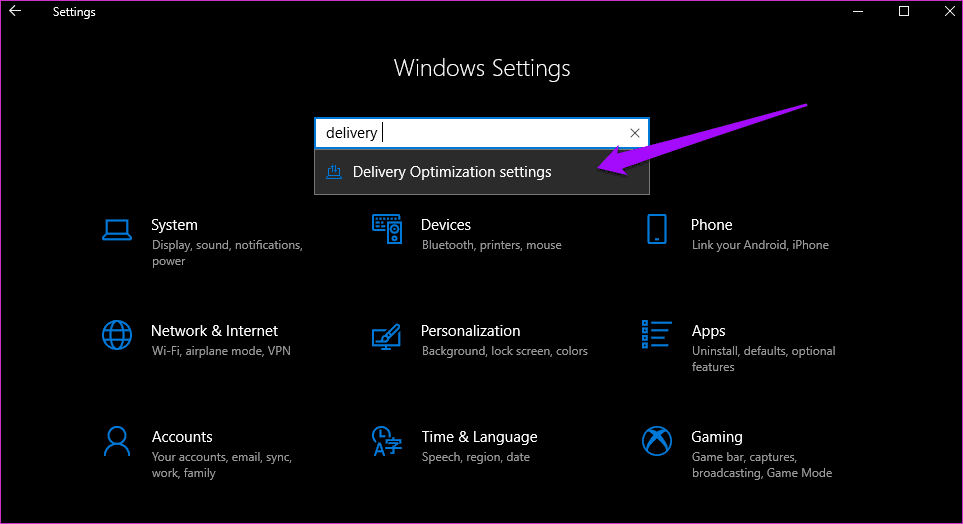
That is where you will toggle Allow downloads from other PCs on and select PCs on my local network.
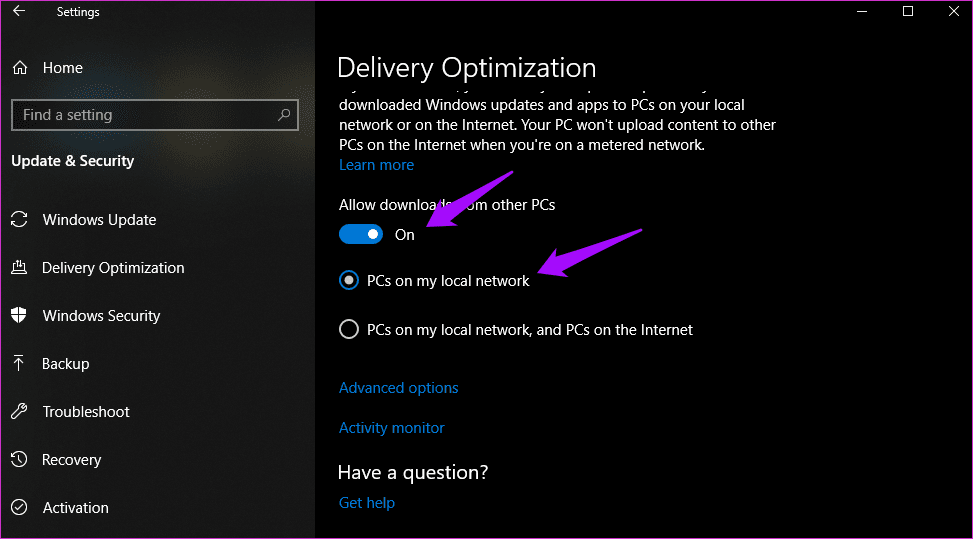
If you can spare some bandwidth and want to speed up the process, there is another option that will tell your PC to download from both the local network and the Internet. Because you are using a local network, you need to check for updates manually once. If Windows detects them on the local network computer, it will begin downloading them.
2. Download in Advance
Downloading an update is one thing and installing those updates is another. These are two different events and knowing the difference can help make a call. If you want to install updates on Windows 10 offline, due to any reason, you can download these updates in advance.
To do this, go to Settings by pressing Windows key+I on your keyboard and selecting Updates & Security.
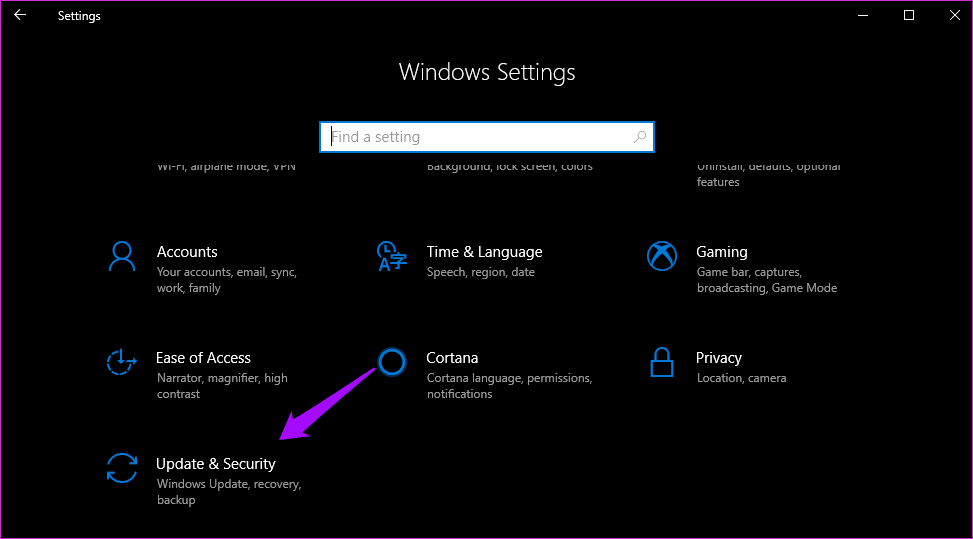
As you can see, I have downloaded some updates already, but they are not installed. Windows is asking me to Restart or Schedule the restart to install these updates. Pretty self-explanatory. I usually schedule the updates so that I don’t end up wasting my working hours watching my PC install the upgrades.
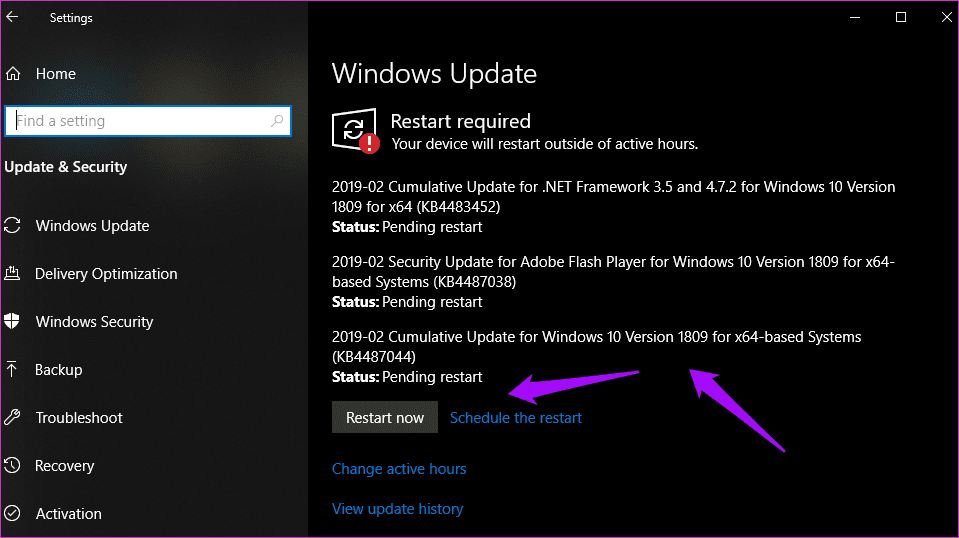
When there are updates found, you will see an option to download them. Click on the download button in the above screen to get the updates when you are connected to the Internet. You can then install them later offline.

To schedule the installation of updates at a later point in time, click on Schedule the restart and pick a time. It has to be on the same day.
Bonus Tip: To make sure that future updates do not happen during your working hours, click on Change active hours on the same screen to choose a time outside your working hours.
3. Media Creation Tool
Microsoft’s Media Creation Tool helps users to create bootable USB flash drives or burn .ISO to a DVD. I prefer USB drives because you can always start over if something goes wrong. The tool is available only after you’ve completed the selection process of choosing the right Windows 10 version (32-bit or 64-bit) for yourself. After you have accepted the ToS, select Create installation media for another PC.
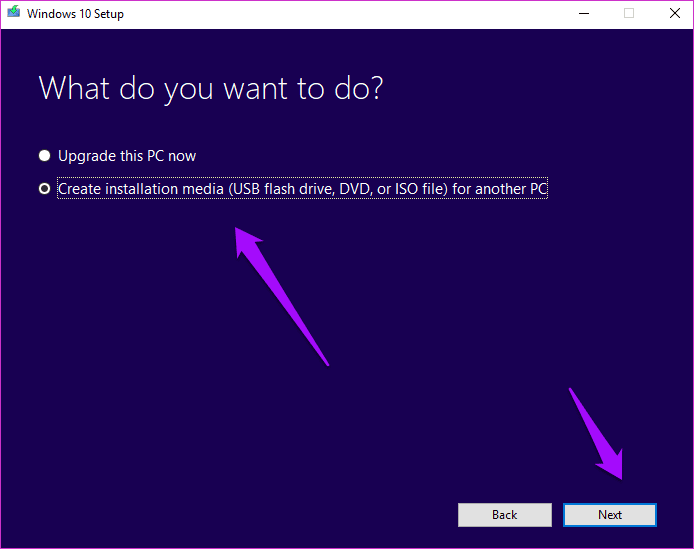
It will detect your language, Windows edition, and architecture automatically or you can select manually. I just go with the recommended options. Click Next.
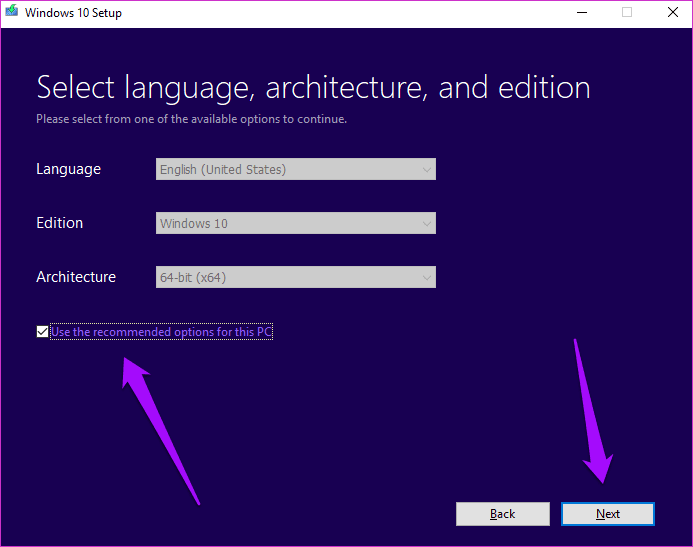
That is where I will select the USB drive, but you can choose to burn the .ISO file to a DVD.
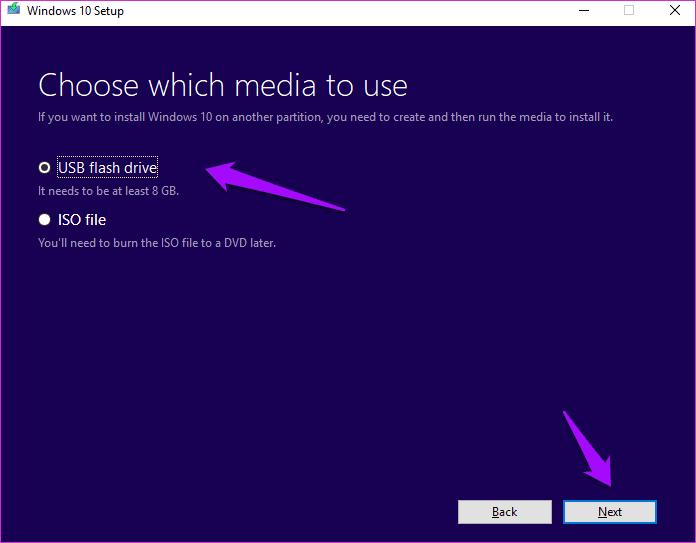
Choose your flash drive if you have more than one connected and click Next.
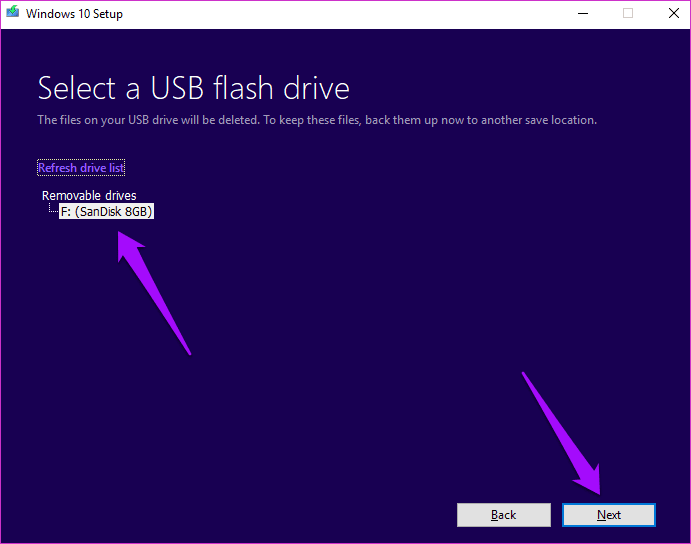
You should now see a Progress screen where the tool will begin the downloading process. Depending on the size of the update, it may take some time. When done, click on finish.
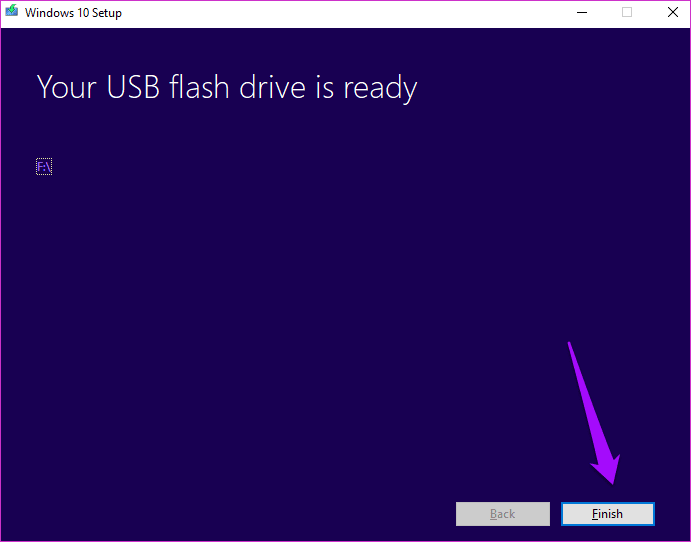
You now have the updates on a USB drive. You can upgrade whenever you want. Just connect the USB drive again and double-click on Setup.exe file to initiate the process.

This is important — select ‘Keep personal files and apps’ here only to install the updates. Otherwise, you may lose data from your hard disk or SSD.
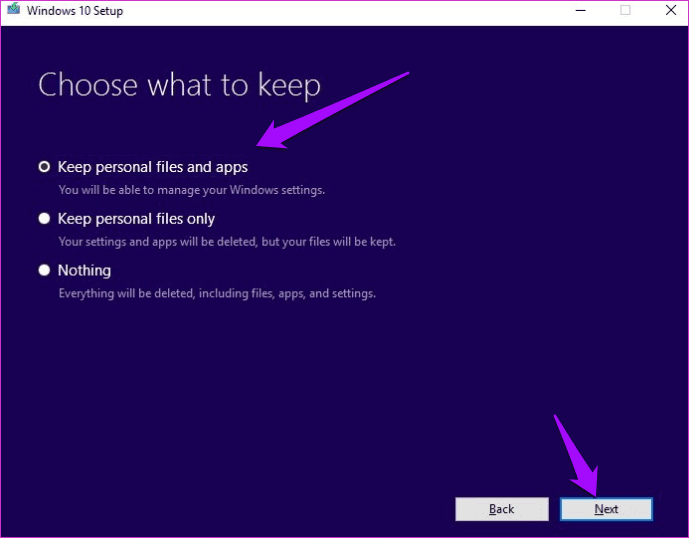
Click on Install on the next screen and wait for the updates to be installed. Windows may take time to apply the updates, and your PC will restart several times, so don’t worry.
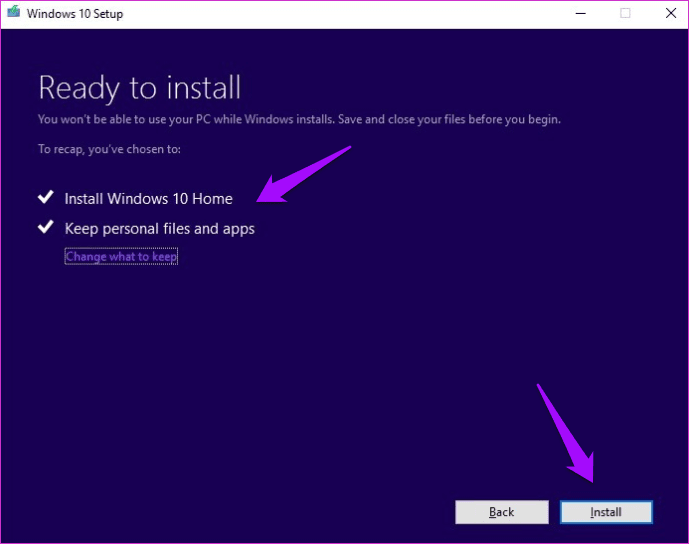
Sometimes, Microsoft will release the .exe files of the updates or patches on their official site. If so, you can download it from there and install them later without an active Internet connection.
Download Media Creation Tool
Pro Tip:
4. Windows Update Catalog
Windows maintains a catalog of all the updates that it has released for a particular OS. You can directly download an update from this catalog (.exe file) and install them offline without an Internet connection on any PC. Visit the catalog homepage using the link below. Search for your OS version or update name if you know it.
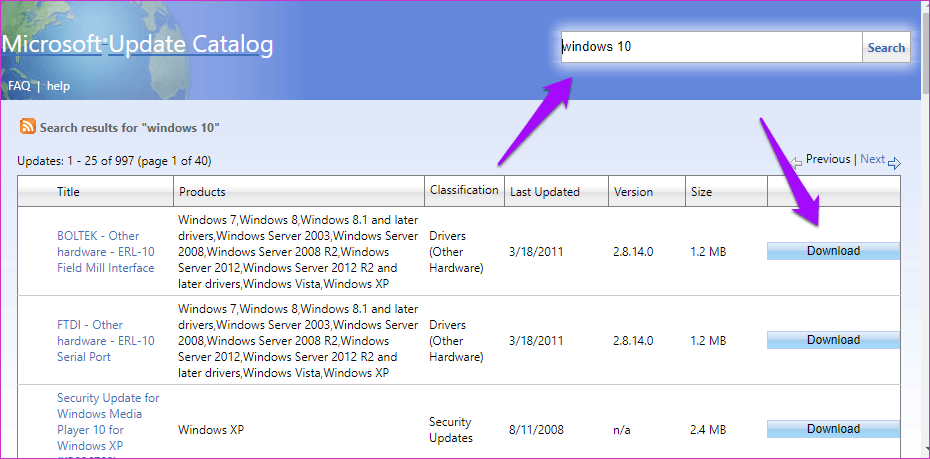
Click on the download button to save the file locally. Just double-click on the downloaded file to install it. Simple.
Visit Windows Update Catalog
Update to Upgrade
I understand that many of you are averse towards installing the Windows updates fearing that it might break something. Well, those days are long gone (hopefully). I recommend you to update Windows 10 regularly so that all the potential security holes and other bugs are fixed. I have set my PC to auto-update Windows 10. If for some reason, you want to install these updates manually, one of the above method should work for you. I have avoided using a third-party tool here for the sake of security.
Next up: Is your Windows PC running slow? Do you see 100% disk usage error in the Task Manager? If so, here are 9 ways to resolve this error and improve your PC performance.
Was this helpful?
Thanks for your feedback!
The article above may contain affiliate links which help support Guiding Tech. The content remains unbiased and authentic and will never affect our editorial integrity.
Readers help support Windows Report. We may get a commission if you buy through our links.
Read our disclosure page to find out how can you help Windows Report sustain the editorial team. Read more
If you have no Internet connection or a bad network but need to update your system, there are ways to update Windows 10 offline.
This is simpler than you think and this guide will show you how to do that, so keep on reading.
How can I update Windows 10 offline?
1. Use updates or patches to update Windows 10 offline manually
-
1. Download the Windows 10 .msu/.exe update files. All installation files can be found on the official Microsoft download page.
-
2. Select the desired Windows 10 Update version, and double-click on it.
-
3. The system will check if the update has been installed before or not. If it’s available on your PC, the installation will begin. All you need to do is follow the on-screen instructions.
-
4. After the installation, restart your PC.
-
5. After the installation, restart your PC.
A great method you can use to update Windows 10 offline is to make use of Windows 10 .msu/exe update files, available for download on the Microsoft website.
This will ensure that you can install the OS without requiring an internet connection, in a very short period of time.
2. Install Windows 10 offline update with the Portable Update
- This method requires the user to install a freeware called Portable Update.
- The advantage is that you can install the same update files on multiple PCs or on one PC multiple times.
- The program will use the standard Windows Update API Service for updating.
- If you don’t like the updated Windows 10, you can roll back to your previous Windows system.
- Disable Hibernation on Windows 10: How to Get Rid of it
- How to Upgrade From 32-Bit to 64-Bit Version on Windows 10
What are the advantages of updating Windows offline?
Offline updates are more stable lowering the chance of the update failing to install. These types of updates are often faster and can be completed at any time.
Do keep in mind that you’ll need to download the update file first, but the installation process won’t require an Internet connection.
In this article, Windows users found detailed instructions for an easy and safe Windows 10 offline update. We also have a guide on how to manually install Windows 10 updates, so don’t miss it.
When using offline updates, you need to access the Microsoft Update Catalog first, but if you encounter any issues, we have a guide on what to do if the Update Catalog is not working.
If you have any additional suggestions or questions, be sure to leave them in the comments section below.
Radu Tyrsina
Radu Tyrsina has been a Windows fan ever since he got his first PC, a Pentium III (a monster at that time).
For most of the kids of his age, the Internet was an amazing way to play and communicate with others, but he was deeply impressed by the flow of information and how easily you can find anything on the web.
Prior to founding Windows Report, this particular curiosity about digital content enabled him to grow a number of sites that helped hundreds of millions reach faster the answer they’re looking for.
Over 86% of computers worldwide operate under the Windows operating system, making it the most popular OS worldwide.
With its regular updates to maintain its user base, sometimes a problem might occur when an update is being carried out, and most times, it’s caused by internet connectivity.
This is not the question you might want to ask. Is it possible to carry out an update/installation offline? This article will talk about how to update Windows 10 offline.
Let’s Talk About the Updates That Can Be Installed Offline
A PC can function properly without installing updates, but that does not mean you should neglect the system’s regular updates.
Installing or software updates is sometimes necessary because it either secures the system or performs better.
Still, operating system updates are meant to improve your system’s performance and secure your files and data from potential threats.
Every day, hackers and researchers develop new bugs and vulnerabilities to enable them to exploit systems. However, Microsoft always ensures that their system is updated so that these exploits can be fixed.
Updates might include new features to address bugs and other issues associated with the PC and give it optimal performance. However, whenever you encounter Windows 10 updates, install them.
A Windows user can change the settings that can delay the updates from installing, but avoiding these updates can lead to security issues or hacking to some extent.
Below are the several ways you can install Windows 10 updates offline.
1. Locally Download the Updates
If you are on a slow or metered network, you need not worry because Microsoft has developed a feature to help you overcome this challenge.
This feature allows you to download Windows updates from another computer using a LAN connection where the update has been received. Follow the instructions below:
- Navigate to the Settings and then go to Delivery Optimization Settings
- Tap on Allow downloads from other PCs, then select the PCs you want on the Local Network.
If you want to speed up the process, you can download it from your local network and the Internet. To do that, check for an update manually before beginning the download.
2. How to Download Your Update In Advance

To install the update, you need to download it. To do this, follow the steps below:
- Go to the Settings and then press I
- Then select Updates and Security
If it schedules a restart, go ahead and install the update. You can install the update later whenever you are offline.
To schedule the installation for another time, click on schedule the restart and pick a time you want it installed.
3. Using Media Creation Tool to Download Updates Offline

You can create a bootable USB flash drive. With it, you can start all over if anything goes wrong.
Remember that choosing the right Windows 10 version/build is very useful in creating the installation media for another PC.
It will also detect the language. You can also burn the ISO file onto a DVD.
Hopefully, the methods above should give you more information about this topic, and it’s up to you to pick which one best suits you.
Windows keeps firing out new updates every month and sometimes you might want to install your Windows 10 updates without having to connect to the internet every time.
This is also the case when you’re installing a fresh copy of your operating system and don’t have the required drivers yet.
Whatever the case may be, we will let you know how to install Windows 10 updates offline.
Why You Need to Stay Updated at All Times
Your PC will function normally even if you don’t install any updates. However, it is always best to keep everything up to date.
This doesn’t only mean the official operating system updates from Microsoft, but also all other software updates and drivers on your system.
Microsoft, along with other software developers release updates to keep their products secure and functioning.
When it comes to your operating system, it is the key to everything on your machine which is why it is crucial to keep it secure.
Every service pack update that has come out for Windows contains tons of different security updates and fixes as well.
The biggest reason why so many security updates come out constantly is because of flaws found within the system by white-hat hackers and bug bounty hunters.
This means once someone has found a flaw in the design, everyone from the malicious side of the user-base will be taking advantage of them as well.
A simple anti-virus or malware software is not enough to keep your files protected, which is why you should download all the updates as soon as they become available.
The only reason you might not need to constantly update your machine is if you never connect to the internet, but this is very rarely the case as nearly every PC user has internet access.
In fact, in order to take full advantage of your system, you need to access the web to even activate it fully. Thankfully we have a bunch of ways to update your Windows 10 offline if you can’t connect to the internet.
Installing Updates Offline via Local Area Network (LAN)
The first method to download Windows updates offline is to grab those updates from another PC in the same network. The only thing this requires is for you to have another machine connected to the same router or network and it needs to have the updates downloaded.
These updates can then be transferred using a brand new feature introduced by Microsoft in Windows 10 operating systems.
Transferring files across a local network is a lot faster than downloading them as the speed is only limited by your routers capacity. It will also spare your internet bandwidth as you don’t need to spend hours downloading the same files twice.
Thankfully the only thing you need to do to enable this feature is to enable Delivery Optimization from the Windows settings.
The only thing you need to do is top open up your Start Menu by pressing the Windows key and typing in Settings.
Open up the Settings app and a new window should open up with a bunch of tabs. Look for the one labelled Update & Security and open it up.
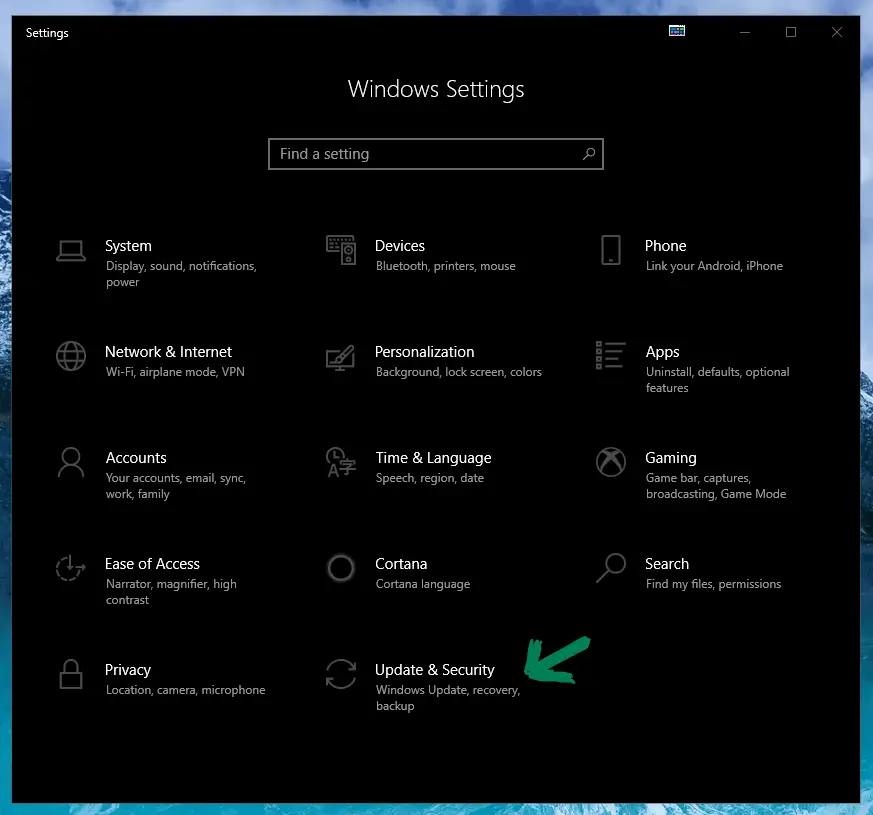
Now that you’re the Updates section of the settings, you should see a Delivery Optimization tab on the left menu.
Click on it to see your delivery optimization settings for Windows. Once opened, you should see a section labelled “Allow downloads from other PCs“.
Now all you need to do is toggle the switch on and select the “PCs on my local network” option to enable local update transferring.
Now you should be able to transfer any updates to your machine as long as you have enabled this setting on your other machines as well.
In some cases, the option to allow downloads from other PCs is disabled or grayed out. This was the case for us, when we tried out this method as well.
We did some research and found a way around this limitation.
How to Fix Grayed Out or Disabled Delivery Optimization
When we were trying to enable Delivery Optimization for our copy of Windows 10 to download and install updates offline, we noticed the option to allow downloads from other PCs was disabled and turned off.
In normal situations this might happen if you are not the system administrator and shouldn’t be messing with these settings in the first place.
However, when using a personal computer while being the System Administrator, this option shouldn’t be disabled.
Note: You can also use this same method to disable downloads from other PCs if you wish.
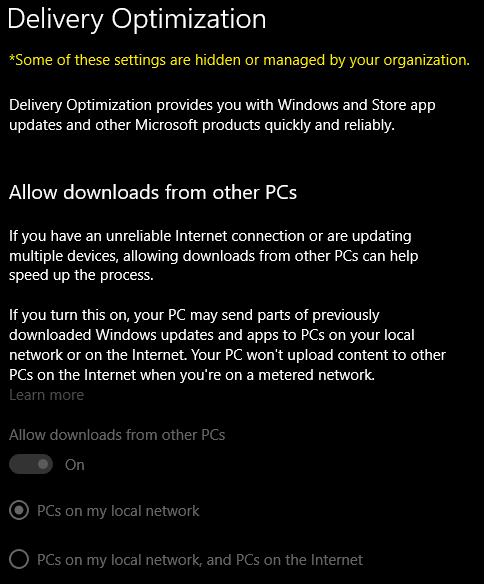
After some research, we found out a way to turn it on. This method basically requires you to edit your Windows registry to enable the feature manually. This might sound a bit sketchy, but it’s a lot easier than it sounds. We attempted it and everything started working perfectly.
We feel obligated to say: take a backup of your registry and files before doing this, but you should be just fine if you follow these steps.
The first thing you need to do is get to your registry files. You can do this by simply typing run in your start menu and launching it.
Then in the Run window, you need to type in regedit and press OK.
You should now see a long folder hierarchy on the left side of the registry window. Navigate to this path: HKEY_LOCAL_MACHINE\Software\Policies\Microsoft\Windows\DeliveryOptimization
Then click on the DeliveryOptimization folder to see the registry entries related to it on the right side of the window.
Next up, you should see a file labelled DODownloadMode on the right. You can double click on it to edit the value.
It has basically 3 options. You can either enter 0 for disabled, 1 for PCs on my local network or 2 for PCs on my local network, and PCs on the internet.
The latter 2 will also enable the feature, setting the selection as shown in the screenshot above.
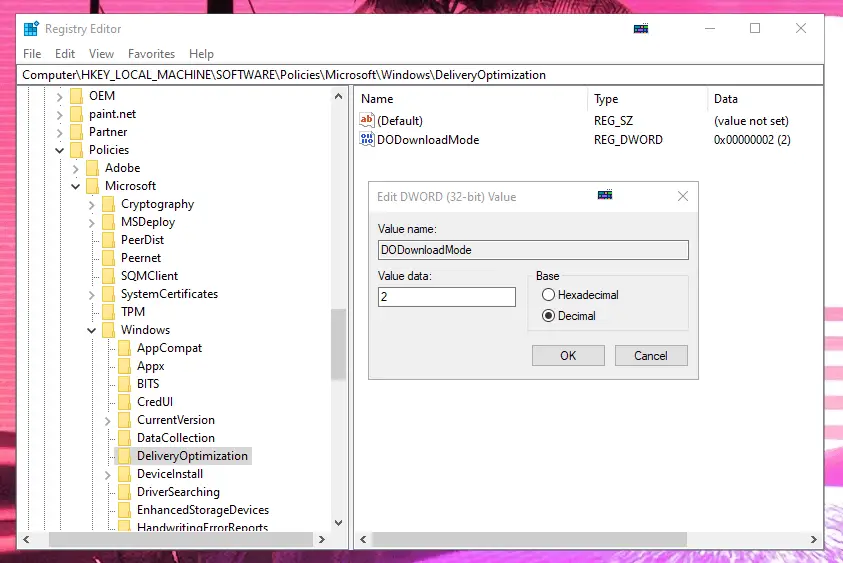
Make sure to select the Base as Decimal then enter either 0, 1 or 2 in the Value data field. Then just press OK and you’re done.
You can always come back and reset it to 0 if it didn’t work for you.
Make sure to restart your PC afterwards to make sure all the settings have fully updated.
Update Windows Offline with the Media Creation Tool
You may have heard of the Microsoft’s official Media Creation Tool. It’s basically a software to format an external drive into a Windows installation format.
It can be used to create a bootable Windows installation from your current operating system. The great thing about it is, if you have installed any service packs or updates, they will be included within the installation.
The reason you need to use this tool is because it’s not possible to just drag and drop Windows update files onto a USB stick.
This is because it needs to be in a official secure format for Windows to accept it. Otherwise there would be a lot higher chance for malicious files and corrupted updates.
To get started with installing Windows 10 updates offline with the Media Creation Tool, you need a few things first. Follow the steps below and you will be set to go.
Setting Up the Media Creation Tool
The obvious first step is to download the tool. You can find the official download page for the tool on the Microsoft website. Follow the link to the website and click on the “Download tool now” button to start the download.
You also need an empty USB flash drive with at least 8 GB of storage space. This is the minimum capacity requirement for the installation files. The drive has to be empty because the tool will overwrite everything on the drive to format it properly. This means if you have files on the drive, they will be deleted.
Now that you have your removable USB storage plugged in, start up the Media Creation Tool. You will have to go through a few prompts like accepting the terms and selecting which format you would like the installation to be in (Language, Windows edition and architecture).
Those settings will default to your current specs, but you can change them as you’d like.
Finally you should see a list of removable drives that can be used for the process.
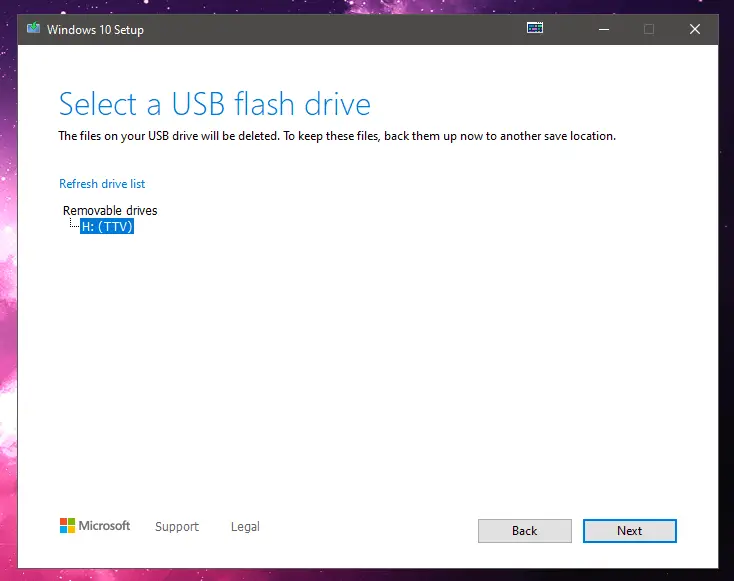
Once you have found one to use, click on Next to start the installation.
It can take quite a while as the whole USB drive needs to be formatted and a lot of files will be installed on it. Once this has been completed, you can move on to the next step, installing the updates on your target machine.
Installing the Updated Windows to Target System
You should now have a flash drive with an official Windows installation on it. The next step is to plug that drive into the machine you wish to update.
Navigate to your “This PC” in your file explorer to see your connected devices. Look for the USB drive and run the “Setup.exe” within the drive.
You will be greeted with the same media creation window you previously installed the files with. Next you need to select whether you wish to keep all your apps and settings on the current system in tact or if you wish to do a clean install.
In our case we want to select the first option “Keep personal files and apps“, as we wish to only update the operating system. This way no files, apps or settings will be affected by this update process.
Finally, all you need to do is click “Next” and then “Install” in the following screen. Note that you will need approximately 10 GB of free space on your machine to run the installer. If you don’t have enough free space, you will see a screen asking to clear up some space.
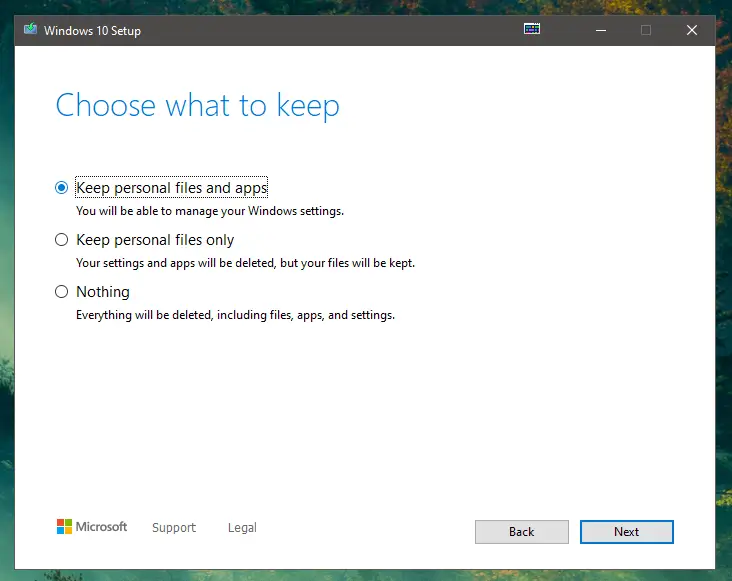
If you can’t clear up any useless data, you can insert a secondary USB drive with enough storage to use as a temporary storage device. This way the installer will use that device to store all the temporary files needed for the installer to finish the setup.
The secondary storage device will not be wiped, so you don’t need to worry about any existing files on it.
Now you should be done and your system will have all the same updates you had on your original operating system, all without an internet connection.
Find Updates via Windows Update Catalog
This final method requires you to find specific updates, download them, and finally install them on any device of your choosing at a later date.
Microsoft stores all their existing update files and installers in the cloud. They have made a nifty list of all of them for you to download. The only issue is that you need to know the name or part of the name of each update you wish to download.
You can access the official update catalog on the Microsoft Update website. You can use the search bar at the top of the page to look for the updates you wish to download.
Once you find an update you need, just click on the download button on the right side. This will open up a new window with a link to the specific file. Clicking on that filename will initiate the download.
Most of the updates will be downloadable in an executable (.exe) format which can be ran directly to install them.
However, some files can only be downloaded as cabinet files (.cab) which are a bit more complicated to install. If you wish to install an update through a cabinet file, you can follow the simple instructions below.
How to Install a Windows Update Cabinet File (.cab)
In order to install a Windows update from a cabinet file, you need to use the Command Prompt. We made an extensive guide on how to use the Windows Command Prompt, if you wish to learn more about all the things you can do with it.
Note: This only works for Windows Update KB installers, not driver installers. If you need to install a cabinet formatted driver, you need to extract the files from the .cab file using an extraction tool like 7-zip, then run the setup.exe found within those files.
First you need to launch the Command Prompt as an administrator. If you don’t know how to do that, check the guide linked above, as it contains an easy newbie friendly way to do so.
Now that you have the cmd opened as admin, you can use the DISM command to install cabinet files. All you need to know is the path to the folder where you downloaded the installation file.
In our case, we moved the file to the following path: C:\Users\TechTipVault\Downloads\windows_update_file.cab
Now that you know the path, use the following format to run the DISM command in the command prompt:
DISM /Online /Add-Package /PackagePath:"C:\Users\TechTipVault\Downloads\windows_update_file.cab"
Although the command has /Online as a parameter, this does not mean you need to be connected to the internet. The parameter just means that this package will be installed to the currently running operating system.
Now you have successfully installed a Windows update or hotfix in a .cab format.
We’ve outlined all the best ways to install Windows updates offline and we hope you found a method that works for you. When it comes to updating an operating system, you should always take a backup of your files as you never now if something goes wrong.
Windows updates are notorious for blue screens and other issues, so it’s better to be safe than sorry. We also recommend checking out how to speed up your Windows 10 to make the updates work faster and smoother in the long run.
